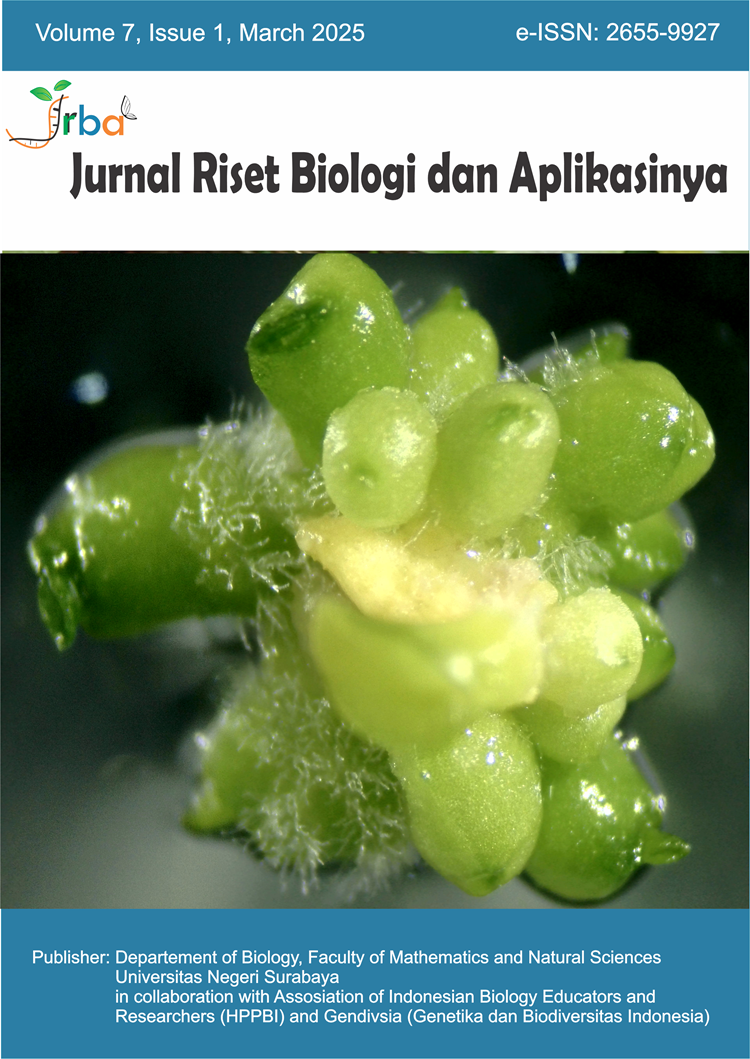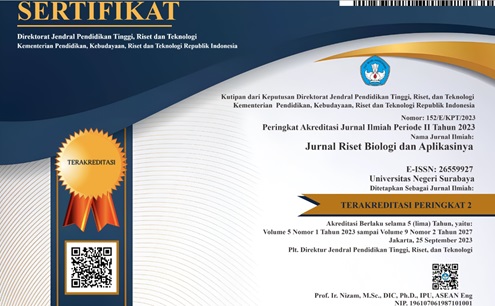Assessing Foliar Chlorophyll Content with SPAD-502 Chlorophyll Meter: A Comparison with Spectrophotometer Method in Various Plants
DOI:
https://doi.org/10.26740/jrba.v7n1.p50-56Keywords:
Chlorophyll analysis, Non-destructive measurement, Spectrophotometry; Leaf pigmentAbstract
Measuring chlorophyll content in plants is one of the main points that has never been ignored in various plant biology and agronomy research studies. Chlorophyll content is a parameter of growth and development, diagnosis of nutritional status, and response to environmental conditions. This study aimed to compare and determine the relationship between SPAD-502 chlorophyll meter readings and chlorophyll content obtained from acetone extraction followed by spectrophotometry measurement. Various leaves with different colors and thicknesses were used to determine the reliability of SPAD readings across diverse morphological traits. The results showed higher SPAD readings in leaves with a greener color. SPAD value was found to have a good linear relationship (r 0.8 and R2 0.64) and a positive correlation with total chlorophyll content, though variations due to leaf thickness suggest the need for correction factors. Furthermore, SPAD has potential as a rapid, non-destructive tool for monitoring plant health and nutrient status in agriculture, plant breeding, and horticulture. This tool can contribute to optimizing crop yield and managing fertilization practice, especially where the maintaining leaf integrity is essential for both commercial and aesthetic value. Species-specific calibration models are recommended to enhance measurement accuracy.
References
Arnon, D. I. (1949). Copper Enzymes in Isolated Chloroplasts Polyphenoloxidase in Beta Vulgaris. Plant Physiology, 24(1), 1–15. https://doi.org/10.1104/pp.24.1.1
Ates, F., & Kaya, O. (2021). The Relationship Between Iron and Nitrogen Concentrations Based On Kjeldahl Method and SPAD-502 Readings in Grapevine (Vitis vinifera L. cv. ‘Sultana Seedless’). Erwerbs-Obstbau, 63, 53–59. https://doi.org/10.1007/s10341-021-00580-8
Banjare, B., Tiwari, S. P., & Ghritlahare, M. K. (2023). Effect of growth media and plant growth regulators on growth attributes of orchid (Dendrobium L.). The Pharma Innovation Journal, 12(6), 4667–4670.
Chanaphai, P., Jongrungklang, N., Puangbut, D., & Songsri, P. (2023). Response of Photosynthetic and Root Traits of Sugarcane Genotypes Under Drought and Recovery Conditions. Sugar Tech, 25(5), 1102–1114. https://doi.org/10.1007/s12355-023-01288-7
Chang, S. X., & Robison, D. J. (2003). Nondestructive and rapid estimation of hardwood foliar nitrogen status using the SPAD-502 chlorophyll meter. Forest Ecology and Management, 181(13), 331–338. https://doi.org/10.1016/S0378-1127(03)00004-5
Cho, A., Chung, S. W., & Kim, Y. J. (2024). Calcium ammonium nitrate applications for improved leaf growth and photosynthetic responses in the CAM orchid Phalaenopsis under elevated CO2 in a greenhouse. Scientia Horticulturae, 324, 112601. https://doi.org/10.1016/j.scienta.2023.112601
Ghosh, M., Roychowdhury, A., Dutta, S. K., Hazra, K. K., Singh, G., Kohli, A., Kumar, S., Acharya, S., Mandal, J., Singh, Y. K., Pathak, S. K., & Gupta, S. K. (2023). SPAD Chlorophyll Meter-Based Real-Time Nitrogen Management in Manure-Amended Lowland Rice. Journal of Soil Science and Plant Nutrition, 23(4), 5993–6005. https://doi.org/10.1007/s42729-023-01457-3
Hu, X., Cao, Y., Zhou, P., Wu, Y., & Korohou, T. W. (2024). Rapid and Nondestructive Evaluation of Rice SPAD Value under Disease Stress Using Hyperspectral Imaging Sensors. Journal of Sensors, 2024. 1–13. https://doi.org/10.1155/2024/3063206
Jinwen, L., Jingping, Y., Pinpin, F., Junlan, S., Dongsheng, L., Changshui, G., & Wenyue, C. (2009). Field Crops Research Responses of rice leaf thickness, SPAD readings and chlorophyll a/b ratios to different nitrogen supply rates in paddy field. Field Crops Research, 114(13), 426–432. https://doi.org/10.1016/j.fcr.2009.09.009
Khoddamzadeh, A. A., & Souza Costa, B. N. (2023). Best Nitrogen Management Practices Using Sensor-Based Smart Agriculture in Nursery Production of Cacao. Horticulturae, 9(4). https://doi.org/10.3390/horticulturae9040454
Ko, S. S., Jhong, C. M., & Shih, M. C. (2020). Blue light acclimation reduces the photoinhibition of Phalaenopsis aphrodite (Moth orchid). International Journal of Molecular Sciences, 21(17), 1–17. https://doi.org/10.3390/ijms21176167
Kumar, P., & Sharma, R. K. (2019). Development of SPAD value-based linear models for non-destructive estimation of photosynthetic pigments in wheat (Triticum aestivum L.). Indian Journal of Genetics and Plant Breeding, 79(1), 96–99. https://doi.org/10.31742/IJGPB.79.1.13
Li, J., Zhou, X., Zhou, J., Shang, R., Wang, Y., & Jing, P. (2020). Comparative Study on Several Determination Methods of Chlorophyll Content in Plants. IOP Conference Series: Materials Science and Engineering, 730(1), 23-37. https://doi.org/10.1088/1757-899X/730/1/012066
Lin, H. H., Lin, K. H., Huang, M. Y., & Su, Y. R. (2020). Use of non-destructive measurements to identify cucurbit species (Cucurbita maxima and Cucurbita moschata) tolerant to waterlogged conditions. Plants, 9(9), 1–15. https://doi.org/10.3390/plants9091226
Lin, Y. J., Chen, Y. C., Tseng, K. C., Chang, W. C., & Ko, S. S. (2019). Phototropins Mediate Chloroplast Movement in Phalaenopsis aphrodite (Moth Orchid). Plant and Cell Physiology, 60(10), 2243–2254. https://doi.org/10.1093/pcp/pcz116
Oliveros, N., Tinini, R., Costa, D. dos S., Ramos, R., Wetterich, C., & Teruel, B. (2021). Predictive models of chlorophyll content in sugarcane seedlings using spectral images. Engenharia Agricola, 41(4), 475–484. https://doi.org/10.1590/1809-4430-Eng.Agric.v41n4p475-484/2021
Pallavolu, L. A., Pasala, R., Kulasekaran, R., Pandey, B. B., Virupaksham, U., & Perika, S. (2023). Analysing the SPAD dynamics of water-stressed vs. well-watered sesame (Sesamum indicum L.) accessions and establishing their relationship with seed yield. PeerJ, 11. https://doi.org/10.7717/peerj.14711
Ruiz-Espinoza, F. H., Murillo-Amador, B., García-Hernández, J. L., Fenech-Larios, L., Rueda-Puente, E. O., Troyo-Diéguez, E., Kaya, C., & Beltrán-Morales, A. (2010). Field Evaluation of the Relationship between Chlorophyll Content in Basil Leaves and A Portable Chlorophyll Meter (SPAD-502) Readings. Journal of Plant Nutrition, 33(3), 423–438. https://doi.org/10.1080/01904160903470463
Sim, C. C., Zaharah, A. R., Tan, M. S., & Goh, K. J. (2015). Rapid determination of leaf chlorophyll concentration, photosynthetic activity and NK concentration of Elaies guineensis via correlated SPAD-502 chlorophyll index. Asian Journal of Agricultural Research, 9(3), 132–138. https://doi.org/10.3923/ajar.2015.132.138
Tan, L., Zhou, L., Zhao, N., He, Y., & Qiu, Z. (2021). Development of a low-cost portable device for pixel-wise leaf SPAD estimation and blade-level SPAD distribution visualization using color sensing. Computers and Electronics in Agriculture, 190, 106487. https://doi.org/10.1016/j.compag.2021.106487
Wakiyama, Y. (2016). The relationship between SPAD values and leaf blade chlorophyll content throughout the rice development cycle. Japan Agricultural Research Quarterly, 50(4), 329–334. https://doi.org/10.6090/jarq.50.329
Wang, N., Yang, G., Han, X., Jia, G., Li, Q., Liu, F., Liu, X., Chen, H., Guo, X., & Zhang, T. (2023). Study of the spectral characters–chlorophyll inversion model of Sabina vulgaris in the Mu Us Sandy Land. Frontiers in Earth Science, 10, 1–15. https://doi.org/10.3389/feart.2022.1032585
Wicharuck, S., Suang, S., Chaichana, C., Chromkaew, Y., Mawan, N., Soilueang, P., & Khongdee, N. (2024). The implementation of the SPAD-502 Chlorophyll meter for the quantification of nitrogen content in Arabica coffee leaves. MethodsX, 12, 1–5. https://doi.org/10.1016/j.mex.2024.102566
Yuan, Z., Cao, Q., Zhang, K., Ata-Ul-Karim, S. T., Tan, Y., Zhu, Y., Cao, W., & Liu, X. (2016). Optimal leaf positions for SPAD meter measurement in rice. Frontiers in Plant Science, 7, 1–10. https://doi.org/10.3389/fpls.2016.00719
Zhang, R., Yang, P., Liu, S., Wang, C., & Liu, J. (2022). Evaluation of the Methods for Estimating Leaf Chlorophyll Content with SPAD Chlorophyll Meters. Remote Sensing, 14, 1–17. https://doi.org/10.3390/rs14205144
Zulkarnaini, Z. M., Sakimin, S. Z., Mohamed, M. T. M., & Jaafar, H. Z. E. (2019). Relationship between chlorophyll content and soil plant analytical development values in two cultivars of fig (Ficus carica L.) as brassinolide effect at an open field. IOP Conference Series: Earth and Environmental Science, 250(1). https://doi.org/10.1088/1755-1315/250/1/012025.
Downloads
Published
How to Cite
Issue
Section
License
Copyright (c) 2025 Jurnal Riset Biologi dan Aplikasinya

This work is licensed under a Creative Commons Attribution-NonCommercial 4.0 International License.
 Abstract views: 475
,
Abstract views: 475
, PDF Downloads: 406
PDF Downloads: 406












